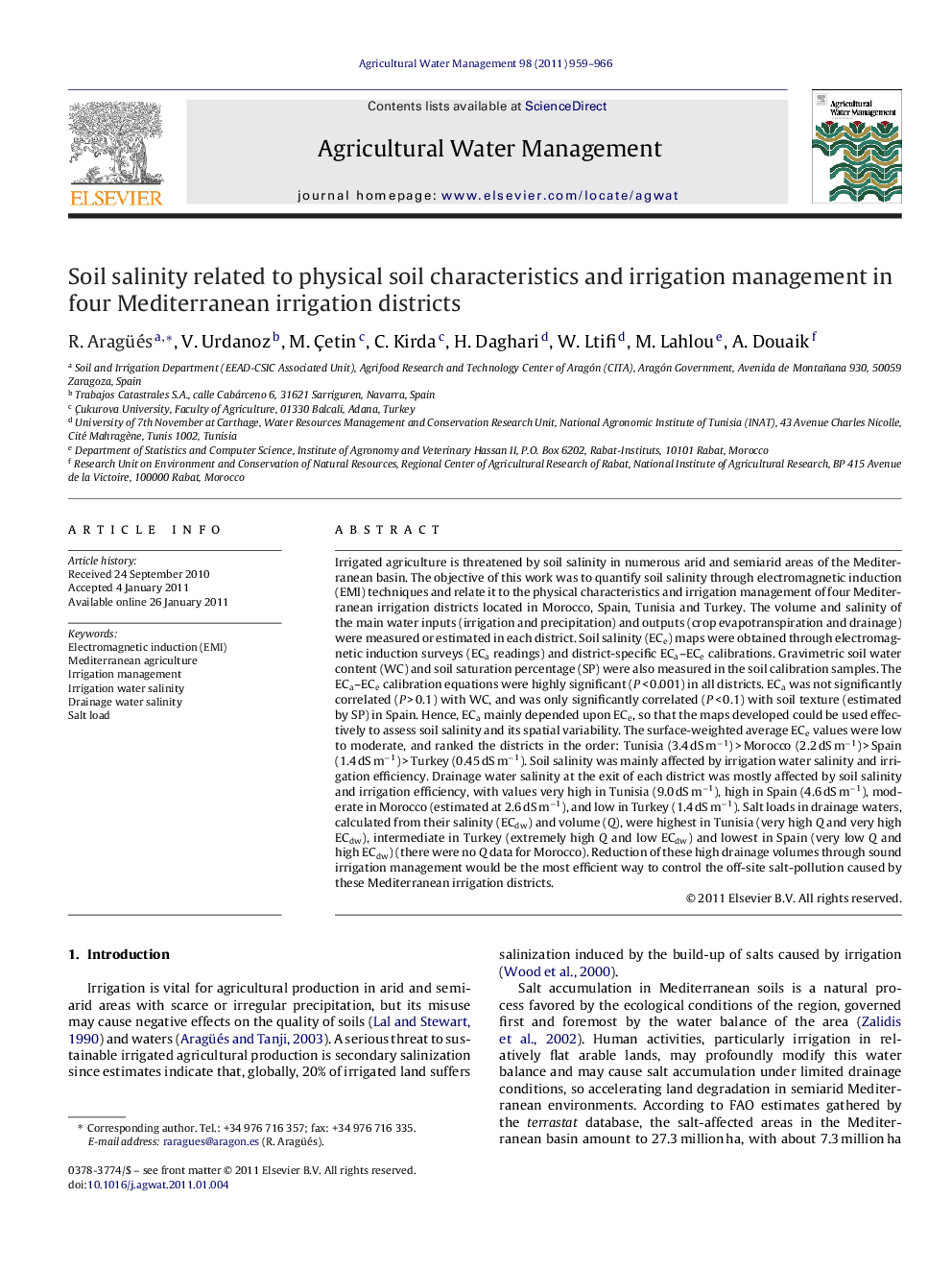| Article ID | Journal | Published Year | Pages | File Type |
|---|---|---|---|---|
| 4479366 | Agricultural Water Management | 2011 | 8 Pages |
Irrigated agriculture is threatened by soil salinity in numerous arid and semiarid areas of the Mediterranean basin. The objective of this work was to quantify soil salinity through electromagnetic induction (EMI) techniques and relate it to the physical characteristics and irrigation management of four Mediterranean irrigation districts located in Morocco, Spain, Tunisia and Turkey. The volume and salinity of the main water inputs (irrigation and precipitation) and outputs (crop evapotranspiration and drainage) were measured or estimated in each district. Soil salinity (ECe) maps were obtained through electromagnetic induction surveys (ECa readings) and district-specific ECa–ECe calibrations. Gravimetric soil water content (WC) and soil saturation percentage (SP) were also measured in the soil calibration samples. The ECa–ECe calibration equations were highly significant (P < 0.001) in all districts. ECa was not significantly correlated (P > 0.1) with WC, and was only significantly correlated (P < 0.1) with soil texture (estimated by SP) in Spain. Hence, ECa mainly depended upon ECe, so that the maps developed could be used effectively to assess soil salinity and its spatial variability. The surface-weighted average ECe values were low to moderate, and ranked the districts in the order: Tunisia (3.4 dS m−1) > Morocco (2.2 dS m−1) > Spain (1.4 dS m−1) > Turkey (0.45 dS m−1). Soil salinity was mainly affected by irrigation water salinity and irrigation efficiency. Drainage water salinity at the exit of each district was mostly affected by soil salinity and irrigation efficiency, with values very high in Tunisia (9.0 dS m−1), high in Spain (4.6 dS m−1), moderate in Morocco (estimated at 2.6 dS m−1), and low in Turkey (1.4 dS m−1). Salt loads in drainage waters, calculated from their salinity (ECdw) and volume (Q), were highest in Tunisia (very high Q and very high ECdw), intermediate in Turkey (extremely high Q and low ECdw) and lowest in Spain (very low Q and high ECdw) (there were no Q data for Morocco). Reduction of these high drainage volumes through sound irrigation management would be the most efficient way to control the off-site salt-pollution caused by these Mediterranean irrigation districts.
Research highlights▶ EMI surveys and the ECa–ECe calibration equations satisfactorily appraised irrigation–district soil salinity. ▶ The calibration equations were site-specific, and must be developed for the particular soils of interest. ▶ The ECa profiles were generally normal or uniform, showing that the soils were subject to salt leaching. ▶ Soil salinity, preponderantly affected by irrigation water salinity and irrigation efficiency, was low to moderate in the four irrigation districts. ▶ Drainage water salinity varied between 9.0 and 1.4 dS m−1 and was related to soil salinity and irrigation efficiency. ▶ The control of off-site salt loads requires the reduction of actual high drainage volumes in two of the studied districts.
